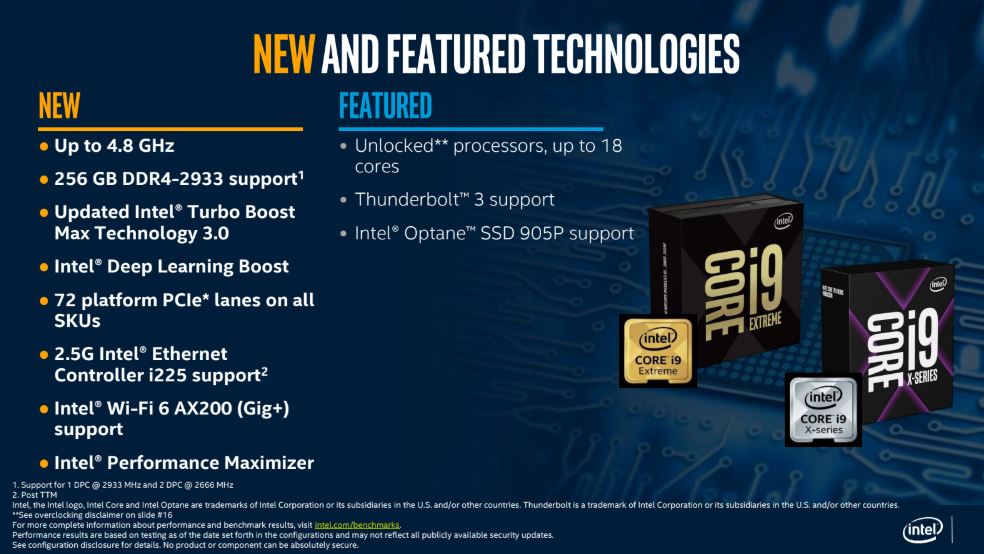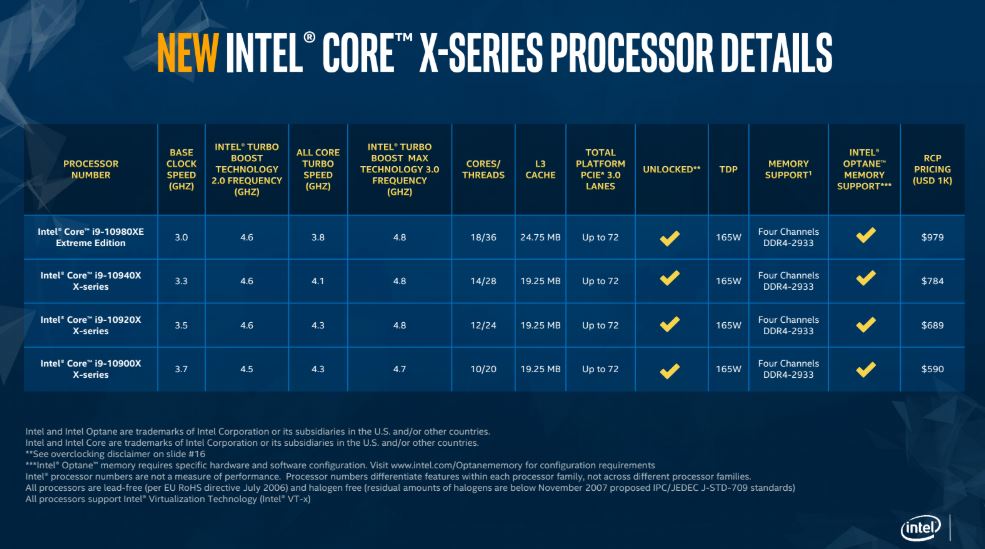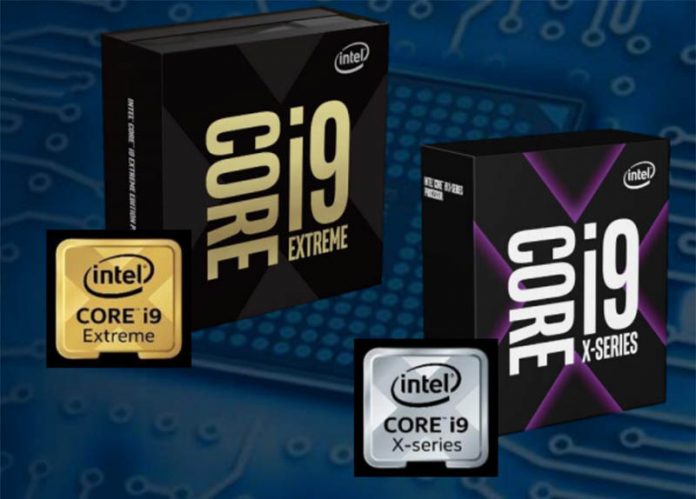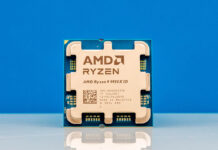Since someone broke the embargo, Intel is allowing us to publish this part of the embargoed information early. Intel is releasing a new series of Core i9 X-Series CPUs with up to 18 cores for only $979. At the same time, the company is also refreshing the platform with some great features. We are writing this up quickly since we just got the OK to publish this due to the leak.
New Intel Core i9-10900 Series Platform Features
First and foremost, the new Core i9 SKUs utilize the LGA2066 platform and Intel is enabling up to 72 platform PCIe lanes. That includes lanes from the C422 PCH, not just the CPU so there is a big caveat there. Intel is practically limited by CPU package pins.

There is support for up to 256GB of DDR4-2933 memory using unbuffered memory. On this series, we asked, and there is no RDIMM support since it is not a Xeon. The new chips also have features like a 4.8GHz maximum turbo boost speed and unlocked multipliers for overclocking. We were told the Intel DL Boost is like what we see on the 2nd Gen Intel Xeon Scalable Platform. Intel also is updating networking with 2.5GbE and Wi-Fi 6 support by collaborating with its board partners. 1GbE is too slow so we hope Intel continues to move the market here.
New Intel Core i9-10900 Series SKUs
There are four new Intel Core i9-10900 series SKUs. The top-end Intel Core i9-10980XE is perhaps the most interesting for our readers. It is the company’s 18 core SKU for only $979.

The SKU stack also has a 10 core Intel Core i9-10900X for only $590 which will prove an intriguing upgrade over the Intel Xeon E-2100 and Xeon E-2200 series with more platform expansion and cores.
Final Words
These are consumer chips that we think our readers will find intriguing. Those using Xeon E5 generation workstations will likely see a big performance boost and lower power consumption with the new Core i9 parts for workstations. Of course, we wish these supported ECC RDIMMs, but Intel reserves that support for Xeon variants of its consumer parts. At under $1000, the Intel Core i9-10980XE is perhaps the best high-end workstation performance per dollar part out there.
More on this set of announcements when we are finally able to discuss them more.





How does this CPU compare with the latest AMD offering? Can you do a comparison performance per watt and $, please.
Hooray for competition. AMD’s success with Threadripper likely contributed directly to this major lineup shift. Good for consumers, AMD now has a few weeks to re-jigger their pricing plan for their upcoming Threadripper 3000 series ‘premiering’ next month. The higher core-count Threadrippers will probably follow afterwards. Going to be a fun few months in the HEDT space. Thanks for covering these Patrick – agree with Jan, looking forward to more comparisons, especially after the upcoming AMD TR3000 series debuts.
I like how this was only possible with what AMD has done in the past 3 years in the HEDT market, although it does cast a lot of shade at Intels previous gen pricing.
Do we have any idea how many usable PCIe lanes are actually available to the user minus the PCH?
Threadripper 2 had 48 PCIe lanes.
Sounds like Xeon-W is still keeping its place for now.
Also, any notes on ECC support?
Emilie: “Threadripper 2 had 48 PCIe lanes.”
Nope! All ThreadRippers have 64 PCIe lanes. Well, 4 of those go to the chipset but OTOH, it has 8 USB 3.0 ports coming off the CPU whose aggregated throughput is comparable to an extra x4 PCIe 3.0 link.
Also, the SATA support for all M.2 slots comes from the CPU itself and does not lower the number of available SATA ports from the chipset when a SATA M.2 drive is used.
BTW, with the new Core X you’d need a new MoBo to make use of the extra 4 PCIe lanes. Yet it’s still so much behind the TR platform that it’s not even funny.
DDR4-2933 is only available with 1DIMM/channel. With 2DIMM/channel the max speed is 2666 (see footnote 1 on the first slide).
The 72 PCI-E lanes is pure marketing wank, these “new” models will only have 48 PCI-E channels with a catch: while they will work on existing X299 boards you will lose those 4 extra lanes. Just like the existing generation the CPU to PCH interface is still DMI 3.0 which is equivalent to PCI-E 3.0 x4. Only reason why Intel now adds these lanes is so it appears they have more total lanes than AMD.
Intel only needs to be remotely competitive with one feature: Price
The fact that Intel has lowered prices 50% is amazing and this is definitely the start of a price war!!
I think Amd has the performance but I don’t see how they can last out Intel in a major price war…
Nikolay: “TR has 64 PCIe lanes”
Ahh yes, not sure where i got 48 from! Just did a deeper than cursory search and you’re right!
So really, as STH generally says on anything AMD related, unless you want optane ssd support, optane persistent DIMMs or have workloads specifically designed for Intel; why not go for AMD?
The 2.5GbE is such a moot point and aeems such an awkward speed to support, would have much rather had seen a 5GbE baked in, might as well go to a better depth!